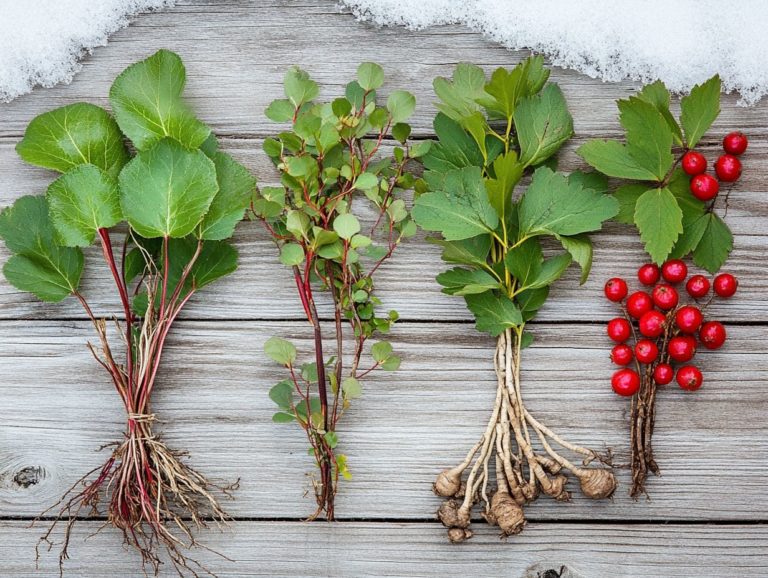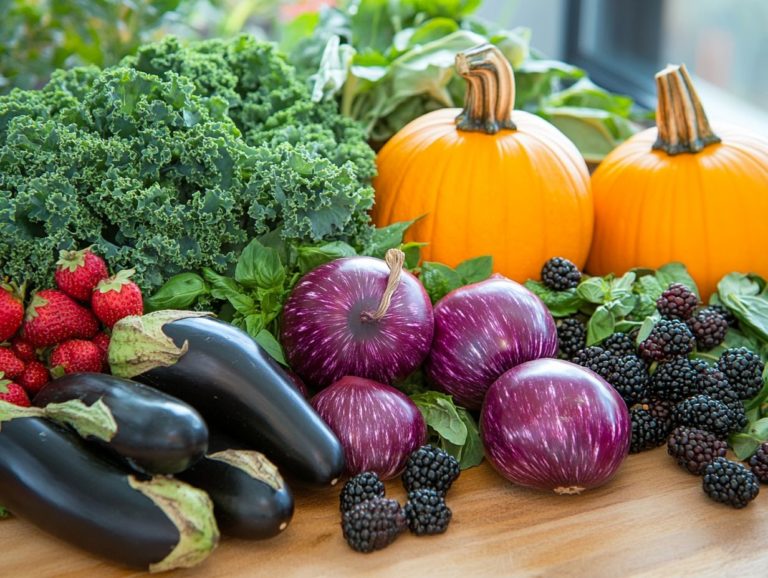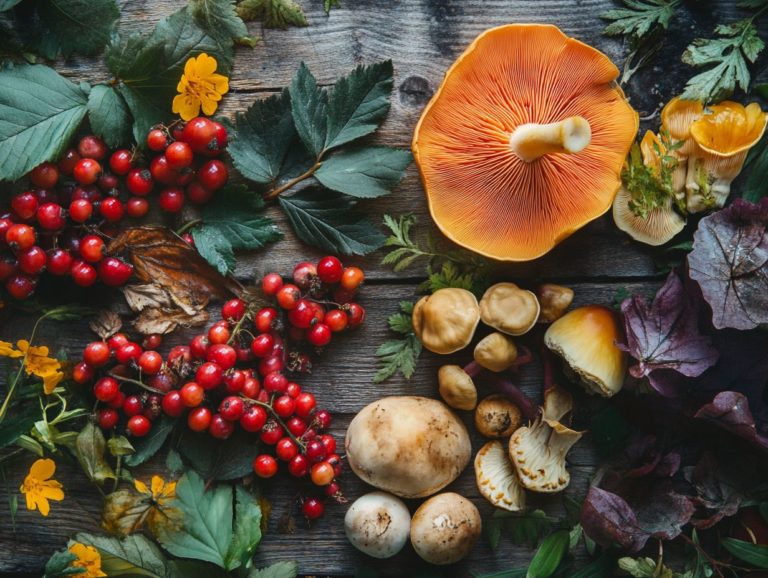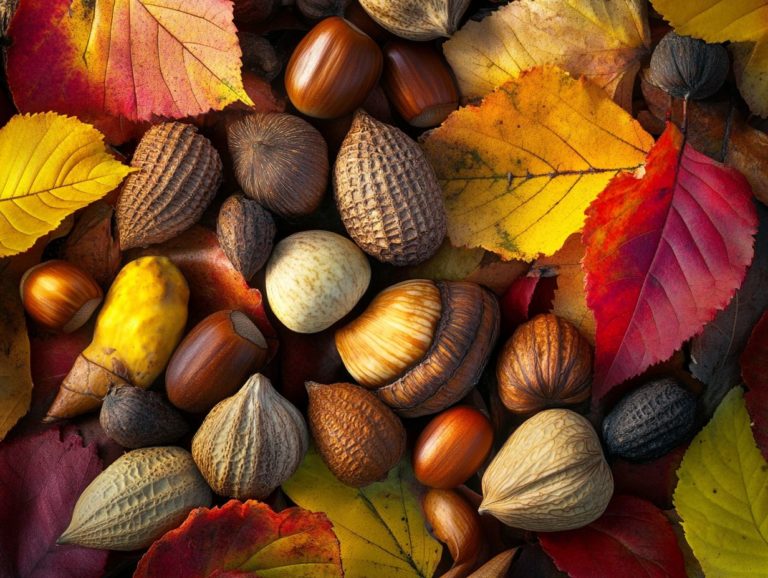The Ultimate Seasonal Foraging Toolkit
Seasonal foraging isn t merely a trend; it s a fulfilling journey that connects you deeply with nature while enriching your diet. Get ready to discover the thrilling joys of foraging all year long!
This article explores the many benefits of gathering wild foods, highlighting their nutritional value and positive impact on the environment.
With practical tips on getting started, identifying safe plants, and essential tools, you ll be fully equipped for every season.
Prepare to uncover the joys of foraging year-round, complete with insights tailored for spring, summer, fall, and winter.
Contents
Key Takeaways:
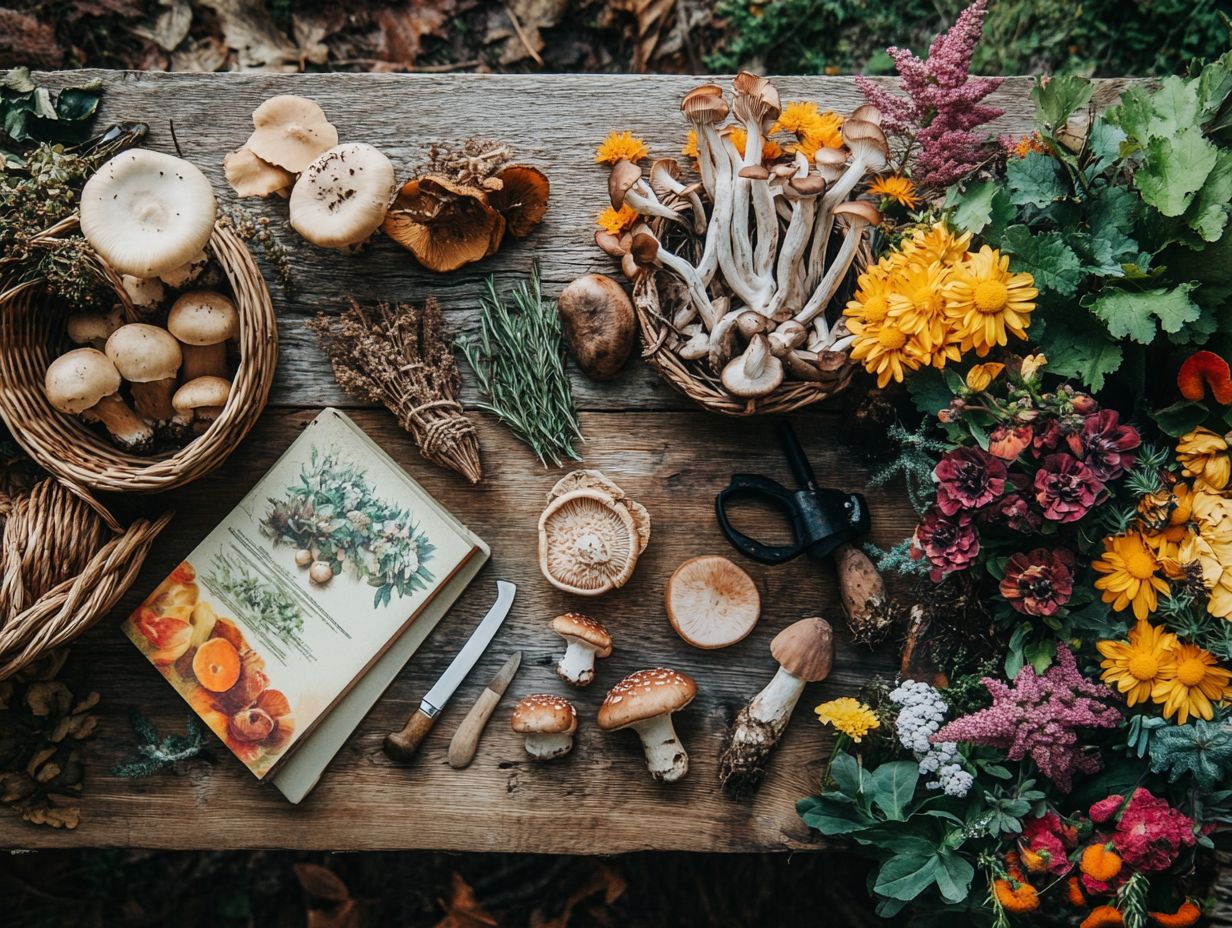
- Seasonal foraging provides nutritional and environmental benefits, as well as a deeper connection to nature.
- Before foraging, learn how to identify safe and edible plants and ensure you have the proper tools and equipment.
- Different seasons offer unique foraging opportunities, such as spring greens and summer berries, making it a year-round activity.
What is Seasonal Foraging?
Seasonal foraging is your ticket to gathering wild foods that align perfectly with the changing seasons. It’s an opportunity to immerse yourself in the natural world, discovering a diverse range of nutritious options throughout the year, and utilizing top resources for sustainable foraging.
This cooking experience not only elevates your meals with fresh, wild ingredients but also deepens your connection to nature. It fosters a sustainable lifestyle that honors traditional food practices.
As a forager, you ll learn to respect your environment and appreciate the abundance of edible wild plants that change with each season. This practice has a rich history dating back to our ancestors who relied on nature’s cycles for survival.
By foraging, you connect with your surroundings, encouraging exploration and mindfulness as you hunt for mushrooms, berries, nuts, and greens tailored to each season.
By incorporating wild foods into your diet, you can enjoy a wide range of nutrients often missing in conventional meals while embracing the benefits of organic, unprocessed ingredients.
Engaging in seasonal foraging cultivates sustainable habits and enhances your appreciation for the variety of life in our ecosystems, motivating you to protect the environments that nourish you.
Benefits of Seasonal Foraging
The benefits of seasonal foraging extend far beyond simply gathering wild foods. They encompass both nutritional and environmental advantages that foster a healthier lifestyle and promote ecological balance.
By practicing sustainable foraging, you can responsibly harvest edible wild plants, enhancing your culinary experiences while developing a deeper respect for the natural world.
The wild ingredients offer unique nutritional benefits often more nutritious than cultivated counterparts providing an opportunity to weave knowledge of gathering wild plants into your modern diet and ultimately enriching your health and well-being.
Nutritional and Environmental Advantages
The nutritional and environmental benefits of seasonal foraging are truly remarkable. By embracing wild foods, you not only gain access to essential nutrients. You also help promote biodiversity and ecological health. Foraging for edible plants means you can enjoy fresh, organic ingredients that often pack a greater punch of vitamins and minerals compared to what you ll find in the store. It s a worthy addition to your diet.
When you engage in sustainable foraging practices, you contribute to the preservation of natural habitats. You also build a good connection with the environment. This approach highlights the importance of respecting and nurturing our ecosystems.
As you gather wild foods, you’re not just enhancing your dietary intake; you’re also playing a part in protecting fragile ecosystems. These wild foods thrive in harmony with their surroundings, adapting to local conditions and requiring fewer resources than their cultivated counterparts, which often rely heavily on pesticides, fertilizers, and extensive irrigation.
Seasonal foraging also helps reduce the carbon footprint linked to transporting food over long distances. It enriches local ecosystems in the process. By participating in this sustainable practice, you cultivate a deeper appreciation for nature and adopt a mindset of mindful consumption, ensuring that future generations can partake in the countless benefits these untouched resources offer.
How to Get Started with Seasonal Foraging
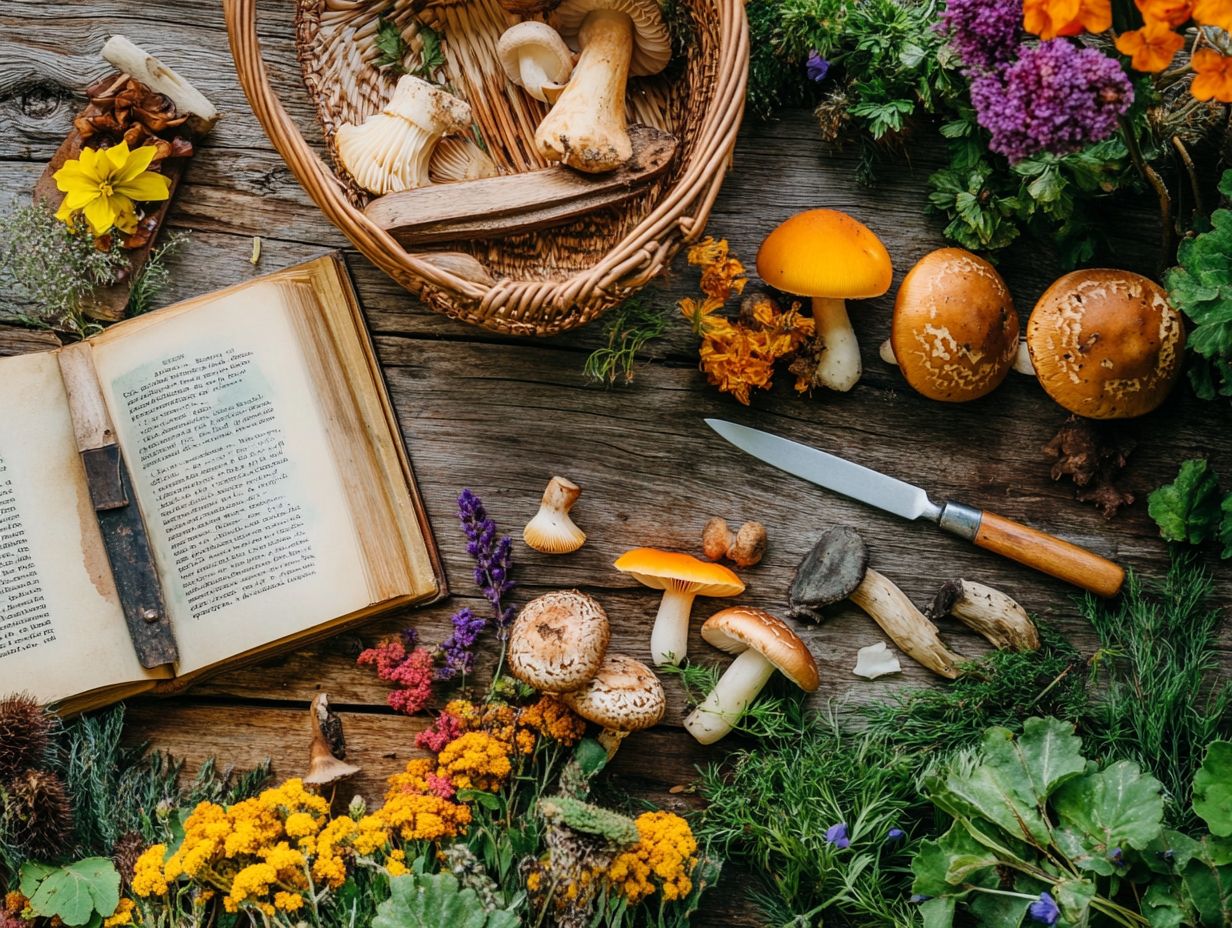
Get ready for an exhilarating adventure in seasonal foraging! It requires you to learn how to identify safe and edible plants, gather the right tools, and immerse yourself in the vibrant tapestry of the natural world.
As you begin this journey, it’s crucial to arm yourself with a reliable foraging guide. This guide should outline local edible wild plants and their distinguishing features to help you steer clear of any potential hazards. Investing in high-quality foraging tools think foraging knives, pruning shears, and sturdy bags will not only enhance your experience but also make your explorations into the diversity of wild foods in your area effective and enjoyable.
So grab your guide and tools, and dive into the world of seasonal foraging today!
Identifying Safe and Edible Plants
Identifying safe and edible plants is an essential skill for you as a forager. This skill allows you to savor the delights of wild foods while steering clear of potential dangers. To embark on this journey, start by consulting a reputable foraging guide that offers detailed descriptions and images of local wild plants. This will help you distinguish between the treasures of nature and their toxic counterparts.
Joining local foraging groups or workshops can further enhance your knowledge through shared experiences. This fosters a richer understanding of the diverse flora available for harvesting while promoting safe foraging practices that honor the natural world and engage in herbal foraging.
Beyond guides and community involvement, pay close attention to visual and sensory cues. Look out for unique leaf shapes and vibrant flower colors as you explore! Leaf shapes, flower colors, and scents will all assist you in recognizing safe plants. Observing growth patterns and environmental conditions will provide vital insights into a plant’s edibility.
It s crucial to approach foraging with caution and responsibility, acknowledging that even some familiar species can have poisonous lookalikes. Seeking advice from seasoned foragers or botany experts people who study plants not only minimizes your risk but also enriches your learning experience. This ensures a comprehensive and safe approach to enjoying nature’s bounty.
Tools and Equipment for Foraging
Equipping yourself with the right tools and equipment is crucial for a successful foraging adventure. This preparation enables you to harvest wild foods efficiently while ensuring your comfort and safety in the great outdoors.
By carefully selecting your gear, you enhance the efficiency of the foraging process and enrich your overall experience. A sturdy foraging basket is essential for easy transport of your gathered edibles. A reliable field guidebook helps you accurately identify both edible and toxic plants.
Items like a compass and a first-aid kit add extra safety, especially when venturing into unfamiliar territory. Prioritizing quality ensures that your comfort and protection remain paramount. Durable equipment can withstand rugged conditions, allowing you to fully immerse yourself in nature while minimizing risks.
Foraging in Different Seasons
Foraging through the seasons presents a remarkable opportunity to uncover a diverse array of wild foods. Each season offers its own unique bounty of edible plants, mushrooms, and fruits waiting to be discovered.
In spring, you’ll delight in tender greens and early blooms. Summer unveils a rich harvest of berries and fragrant herbs. As fall arrives, a treasure trove of mushrooms and nuts beckons. Winter challenges you to seek out hardy plants and preserved edibles.
By understanding the seasonal availability of wild ingredients, you elevate your foraging experience and embrace sustainable practices. These practices honor the natural cycles of growth and harvest.
Spring Foraging Tips and Tricks
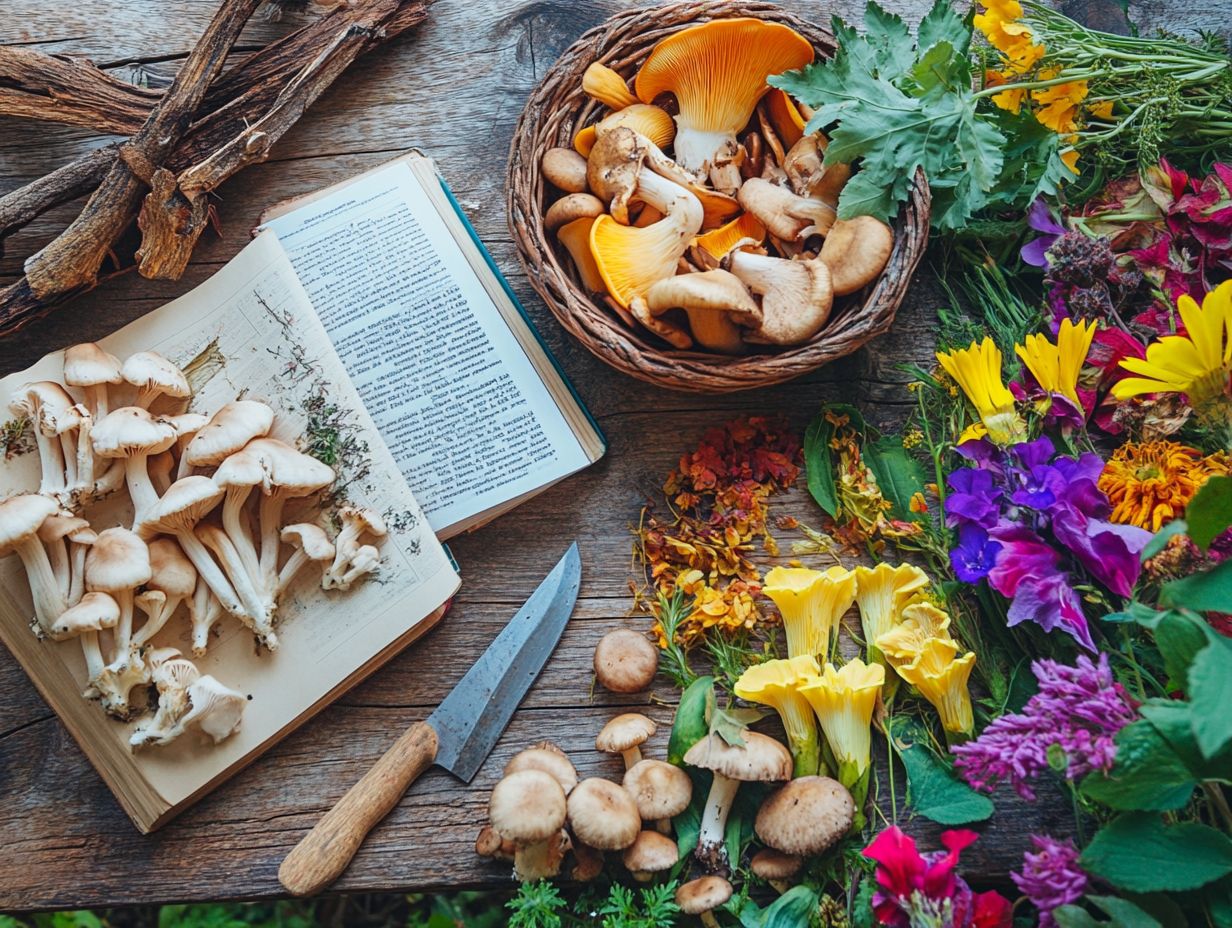
Spring foraging is a delightful experience as nature awakens. You’ll find a bounty of wild foods such as tender young greens, edible flowers, and the first vegetables peeking through the thawing soil.
This seasonal adventure beckons you to explore your local landscapes. Vibrant shades of green signal the arrival of nutrient-rich delights. Among these treasures, wild garlic stands out not just for its flavor, but also for its versatility in pesto and salad dressings.
Dandelion greens, with their peppery kick, can be saut ed to create robust side dishes or tossed into lively spring salads. Nettles, celebrated for their health benefits, can elevate a simple soup into a nutrient powerhouse when prepared just right.
As you embark on these culinary explorations, keep in mind the importance of ethical harvesting practices. Gather only what you need and leave enough for wildlife to thrive and for plants to regenerate in the seasons ahead.
Summer Foraging Tips and Tricks
Dive into summer foraging and discover a vibrant selection of berries, herbs, and wild vegetables. Each offers a burst of flavor that elevates your meals.
As you wander under the warm sun, picture yourself among lush landscapes where elderflowers bloom. These blooms are perfect for crafting your own homemade elderflower syrup. Imagine meadows sprinkled with dandelions, their leaves a fantastic addition to salads and their flowers ideal for brewing wine.
Timing is everything in foraging. You’ll find that berries are sweetest in the early morning. Gather herbs just before they bloom to maximize flavor.
By using gentle techniques, like snipping leaves instead of uprooting plants, you can help preserve these wild treasures for future seasons. This ensures that others can also savor the joys of foraging.
Fall Foraging Tips and Tricks
Fall foraging reveals a captivating array of wild foods think mushrooms, nuts, and robust greens ready to be harvested before the chill of winter sets in. This season is not just about gathering; it s an essential moment for you as a forager to immerse yourself in nature and deepen your understanding of local ecosystems.
Imagine wandering through the woods. Mushroom lovers like you might discover the earthy allure of chanterelles and the rich complexity of porcini. Meanwhile, wild greens such as dandelion and lamb’s quarters beckon with their nutritional punch and versatility in the kitchen.
Embrace responsible harvesting practices. Only take what you need and ensure there’s plenty left for wildlife and future growth. This mindful approach fosters a sustainable relationship with the environment, allowing you to enjoy the fruits of your labor while nurturing the ecosystem that supports it.
Winter Foraging Tips and Tricks
Winter foraging presents you with a unique challenge. It invites you to seek out hardy plants and stored foods that withstand the chill, allowing you to connect with nature even amidst the depths of winter.
During this season, you can employ various strategies to maximize your finds. Navigate local ecosystems to uncover resilient species that thrive despite the frost. Edible plants like chickweed and wintercress offer vital nutrients and flavors, while preserved mushrooms and roots stand as reliable staples from your previous harvests.
Equipping yourself appropriately is essential. Don insulated clothing, carry durable canvas bags for your collections, and keep a trusted field guide close at hand to enhance your experience.
Turn those cold, barren days into exciting adventures for wild foods!
Frequently Asked Questions
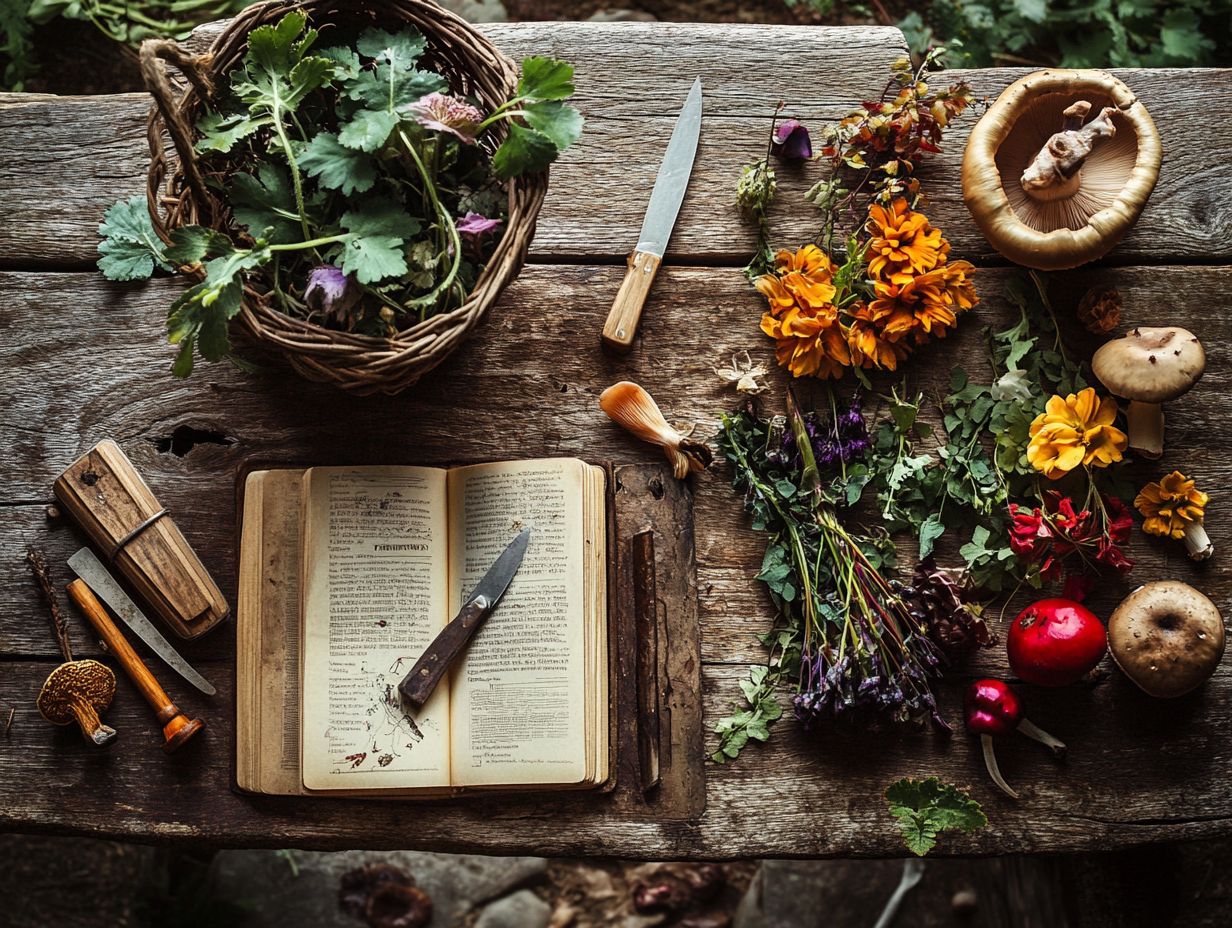
What is The Ultimate Seasonal Foraging Toolkit?
The Ultimate Seasonal Foraging Toolkit is a comprehensive collection of resources and tools for individuals interested in foraging for food, including a detailed seasonal foraging checklist to guide what to harvest throughout the year.
What does the toolkit include?
The toolkit includes a seasonal foraging guide, identification cards for different types of plants, a foraging journal, and recipes for cooking with foraged ingredients.
Why is seasonal foraging beneficial?
Seasonal foraging allows individuals to connect with the natural environment and obtain fresh, nutrient-packed food that is free of pesticides and other harmful chemicals.
Do I need to have foraging experience to use the toolkit?
Whether you re just starting out or a seasoned pro, this toolkit has everything you need!
How can I access The Ultimate Seasonal Foraging Toolkit?
The toolkit is available for purchase online. It can be downloaded as a digital file or shipped as a physical package.
Is the toolkit suitable for all regions?
While the guide and identification cards are based on plants commonly found in North America, the foraging journal and recipes can be used in any region. The toolkit includes tips for adapting to different climates and environments.

![What to Know About Seasonal Foraging in [Your Area]](https://forageadept.com/wp-content/uploads/2024/08/what-to-know-about-seasonal-foraging-in-your-area-HB-768x578.jpeg)
